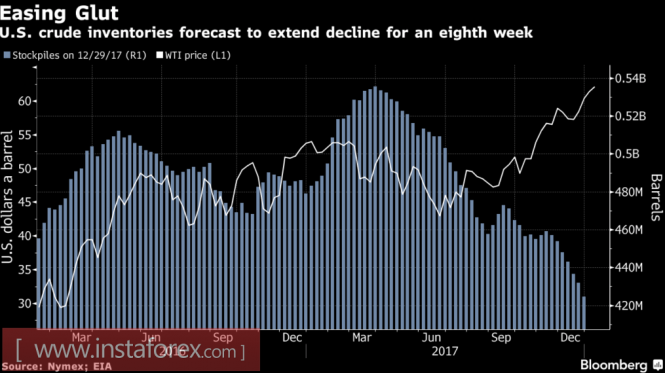Frosts in the northeastern United States, the continuing decline in US oil reserves, the anti-government strikes in Iran, the high level of compliance with contractual obligations by OPEC members, and the weakness of the dollar pushed the quotations of Brent and WTI to the area of three-year highs. However, some of black gold's advantages, in particular, problems with supplies in the North Sea and in Libya, have already been played. Tehran has not reduced production and the US currency is beginning to win back part of the losses incurred at the turn of 2017-2018 decline. These circumstances require that the "bulls" have evidence that they are able to retain both varieties at current levels.
According to the consensus forecast of Bloomberg experts, by the week ending in January 5, oil reserves in the United States have already decreased by 1.5 million barrels. If this is the case, the figure will drop 8 five consecutive days and will reach a minimum mark since the beginning of 2015. At the same time, the number of drilling rigs, according to the latest report of Baker Hughes, unexpectedly decreased by 5. It seems that the rate that shale oil producers will increase its own activity as WTI moved above $ 60 per barrel, was not justified. However, this threat made Iran's oil minister say that OPEC does not want Brent to go far from $ 60.
Dynamics of WTI and US oil reserves

Source: Bloomberg.
Tehran is forced to use this rhetoric as part of the "bullish" news for black gold comes from it. The country, which accounts for about 4% of world production (3.8 million bpd), cannot afford to live in the face of the growing risks of an anti-government coup. It indeed has retained its previous production levels but who knows what will happen tomorrow. The situation is aggravated by the conflict between Iran and Saudi Arabia over Yemen as well as rumors that Donald Trump will not confirm the terms of the nuclear deal with Tehran. The renewal of sanctions is fraught with a reduction in world production and rising prices.
The world demand plays an important role in the current Brent and WTI rally. According to IMF forecasts, the global GDP will grow by 3.6% in 2018. At the same time the increase in consumption of black gold increased to 5 million bpd from 2015 to 2017. However, at the time when the North Sea grade was quoted at $ 100 per barrel or higher, it did not reach +1 million bpd. The continuation of the northern oil campaign will have an impact not only on demand, but also on inflation. Accelerated growth in consumer prices in the US will contribute to the aggressive monetary restriction of the Fed, which will strengthen the position of the dollar. Currently, the US currency has an undisclosed potential. First, the market ignored the factor of tax reform and it is quite capable of winning it back. Second, the divergence in the monetary policy of the Fed and its main competitors continues to work in favor of the USD index.
Technically, if the "bulls" for Brent manage to keep the positions won, then the risks of continuing the rally in the direction of the target by 200% on the AB = CD pattern will increase. On the contrary, falling prices below $ 66.95 per barrel will open the door for correction.
Brent, daily chart

